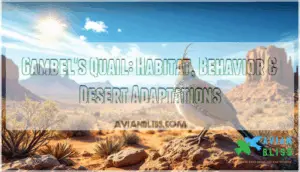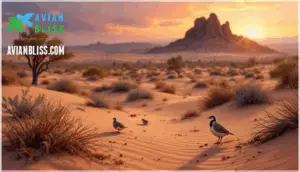This site is supported by our readers. We may earn a commission, at no cost to you, if you purchase through links.

While most birds flee harsh environments, these ground-dwellers thrive where temperatures soar past 110°F and water is scarce for months. They’ve mastered tricks most desert animals never learn: extracting nearly all their water from seeds and succulent plants, timing their breeding to rainfall patterns, and vanishing into thorny cover when predators appear.
Their distinctive teardrop topknots and rusty crowns make them unmistakable, but it’s their desert adaptations that make them extraordinary.
Table Of Contents
- Key Takeaways
- Overview of Gambel’s Quail
- Habitat and Behavior
- Reproduction and Development
- Population and Conservation Status
- Comparison With California Quail
- Frequently Asked Questions (FAQs)
- Where does a Gambel’s quail live?
- What does a Gambel quail look like?
- Why are gambel quails called quail?
- Do Gambel’s quail live in the Sonoran Desert?
- What do Gambel quails eat?
- How do Gambel’s quail survive?
- Can you keep Gambel’s quail?
- Are Gambel’s quail endangered?
- Do gambel quail mate for life?
- What is the difference between Gambel’s quail and California quail?
- Conclusion
Key Takeaways
- Gambel’s quail survive brutal Southwest desert conditions by extracting up to 90% of their water from seeds and succulent plants, rarely needing to drink from streams or springs.
- These ground-dwelling birds use communal roosting in thorny vegetation and travel in coveys of up to 40 individuals to outsmart predators like coyotes and hawks through group detection and defense.
- With a stable population of around 5.3 million birds rated as "Least Concern," Gambel’s quail aren’t endangered, though habitat loss from fire, development, and climate change still threatens localized populations.
- Unlike California quail, Gambel’s quail display bolder desert adaptations—males have striking chestnut caps and rufous-red sides, and they stay within 100 yards of water sources in arid riparian zones and mesquite thickets.
Overview of Gambel’s Quail
If you’re looking for a bird that’s mastered the art of desert living, Gambel’s quail might just be your perfect example. These plump, ground-dwelling survivors belong to the New World quail family and thrive across the desert Southwest, from Arizona to western Texas. You’ll recognize them instantly by their distinctive comma-shaped topknots that curve forward like a question mark.
Species Classification places them as Callipepla gambelii, a standout in Desert Ecology. Males flaunt rust-colored crowns, black belly patches, and bold facial markings—Feather Patterns that make bird identification straightforward. Females sport more subdued tan and chestnut tones but share that signature crest.
Unlike many species, Quail Migration isn’t part of their playbook. Gambels Quail stick close to home year-round, relying on Bird Socialization in coveys of up to 40 individuals. This communal approach helps them outsmart predators like coyotes and hawks that patrol their territory. Through clever adaptations and group dynamics, Gambels Quail Behavior demonstrates what real desert resilience looks like.
Habitat and Behavior
Gambel’s quail don’t just survive in the desert—they’ve mastered it. These birds have developed specific adaptations and behaviors that let them thrive where water is scarce and temperatures swing wildly. Let’s look at how they pull it off.
Desert Adaptations
Gambel’s Quail have cracked the code on desert survival through water conservation and heat tolerance that would make any desert wanderer jealous. You’ll notice these birds pull up to 90% of their water from succulent plants and seeds, rarely needing a drink from streams or springs. Their thermoregulation strategies kick in when temperatures soar—they hunker down in dense mesquite or catclaw shrubs offering over 30% shade cover, avoiding the brutal midday sun.
Gambel’s quail extract 90% of their water from plants and seeds, sheltering in dense desert shrubs to avoid scorching midday heat
Dietary flexibility helps them target moisture-rich cactus fruit and green vegetation during droughts.
These shelter preferences and avian ecology adaptations make Gambel’s Quail true champions of desert ecosystems, embodying desert survival strategies that keep them thriving where others would wilt. The birds’ ability to thrive in harsh environments is closely tied to their desert ground dwelling habits.
Foraging Behavior
When survival’s on the line in the desert, you’ll find Gambel’s quail scratching and pecking across the ground with a hustle that never quits. Their foraging strategies center on seed selection from grasses and shrubs, plus leaves and cactus fruit that boost water intake without needing streams.
You’ll spot them working in flocks at dawn and dusk—this group behavior sharpens efficiency while keeping predators guessing. Their diet shifts with seasons, targeting moisture-rich food sources when drought hits, proving these birds know desert foraging inside and out.
Roosting Habits
After a day spent scratching through the sand for seeds and fruit, these desert birds don’t just crash anywhere—they head for the safety of thick bushes and low trees where the real work of staying alive begins.
You’ll find Gambel’s quail practicing communal roosting in dense, thorny vegetation—packing together in tight flocks where social behavior kicks into high gear. This roosting habit isn’t just about warmth; their roost site selection shields them from coyotes and hawks prowling after dark. Flock dynamics at night mean better predator detection, giving these desert birds the edge they need to survive until dawn’s next forage.
Reproduction and Development
Gambel’s quail don’t waste time regarding raising the upcoming cohort in the harsh desert. Their breeding cycle is tightly linked to rainfall and food availability, with timing that can mean the difference between success and failure.
Let’s break down how these birds manage nesting, incubation, and the rapid development of their young.
Nesting Habits
If there’s one thing these plump desert birds take seriously, it’s finding the perfect spot to raise a family. Nest site selection happens close to cover—you’ll find these scrapes hidden under shrubs or brush. Females manage most of the nesting work, creating shallow depressions lined with grass and feathers.
Their nesting habits include:
- Ground-level nest construction near protective vegetation
- Camouflaged egg laying in exposed dirt
- Minimal nesting materials—just dried grass
- Strategic avian nesting locations near escape routes
- Brood care shared between both parents after hatching
The nest itself stays simple and functional.
Incubation Process
Once that nest is secure, the female settles in for a three-week marathon of warmth and vigilance. She manages incubation solo, rotating those 10-12 speckled eggs to maintain steady egg temperature across the clutch. The incubation period spans 21-23 days, with hatching success tied directly to her ability to shield eggs from scorching desert heat and prowling predators.
Once the young crack through their shells, brood care shifts—both parents step up to guide the precocial chicks away from nesting sites within hours.
Growth Stages
From the moment they pip through their shells, Gambel’s quail chicks launch into a crash course in desert survival—transforming from downy, golf ball-sized hatchlings into feathered replicas of their parents in just weeks. During juvenile growth, you’ll witness three striking milestones in Callipepla gambelii chick development:
- Week One: Precocial hatchlings sprint after parents, fueled almost exclusively by beetles and grasshoppers
- Fledgling Phase: Those signature comma-shaped topknots emerge during plumage maturation around week three
- Molting Process: Adult-like feather patterns solidify by week ten, marking independence
This accelerated growth strategy keeps vulnerable juveniles one step ahead of desert predators.
Population and Conservation Status
Gambel’s quail aren’t on the edge of extinction, but their future depends on how we manage the desert. You’ll find these birds scattered across the Southwest in decent numbers—for now.
Here’s what you need to know about their population health, the people working to protect them, and the changing climate that’s rewriting the rules of desert survival.
Population Statistics
Gambel’s quail populations remain steady across the Southwest, with around 5.3 million birds roaming desert landscapes. These hardy survivors maintain their numbers despite habitat fragmentation and climate vulnerability, though population dynamics shift with rainfall patterns. Species distribution spans California to Texas, with conservation status rated as Least Concern. Population trends fluctuate locally—dry years mean smaller broods, while wet seasons boost demographic analysis numbers. The birds’ ability to thrive is also influenced by their ground nesting habits.
Conservation metrics show these birds adapt well to suburban sprawl, but conservation efforts must address habitat loss from fire and development.
| Population Metrics | Current Data |
|---|---|
| Global breeding population | ~5.3 million birds |
| Conservation concern score | 9 out of 20 |
| Average home range | 954 acres |
Conservation Efforts
Conservation efforts for Gambel’s quail center on habitat restoration and wildlife preservation. Organizations like Quail Forever champion ecosystem management through targeted conservation strategies. You’ll see four major initiatives driving environmental protection:
- Restoring 35,000 acres through a $24.5 million USDA grant in Arizona
- Installing water developments across desert regions since the 1940s
- Managing invasive species through brush control and prescribed fire
- Supporting research through endowments like the $400,000 Borderlands Research Institute fund
These wildlife conservation programs integrate livestock management with ecological conservation, guaranteeing habitat preservation benefits both ranchers and quail populations.
Climate Change Impact
Temperature shifts and desert expansion are rewriting the survival playbook for Gambel’s quail across southwestern landscapes. You’re watching water scarcity intensify in their already-arid desert habitat, forcing these resilient birds to spend over 85% of their time within 100 yards of riparian zones.
Climate change impacts hit reproduction hard—smaller clutch sizes in dry years mean fewer chicks.
Ecosystem disruption from invasive plants and fire compounds the pressure, with over 900,000 acres lost in southern Nevada alone. Unlike their California quail cousins, Gambel’s quail face steeper odds as desert ecosystems transform under mounting climate stress.
Comparison With California Quail
At first glance, you might mix up Gambel’s quail with their California cousins—they’re cut from similar cloth, after all. But spend time watching these desert dwellers, and the differences jump out at you like tracks in sand.
Let’s break down how these two quail species stack up against each other in looks, lifestyle, and where they call home.
Physical Differences
When comparing Gambel’s Quail to their California cousins, you’ll spot some key physical differences right away. Both birds rock that signature topknot, but Gambel’s pull off a bolder desert look. Males sport chestnut caps and striking black masks, while their sides blaze with rufous-red panels edged in white—way more dramatic than California Quail’s scaly belly patterns.
| Feature | Gambel’s Quail | California Quail |
|---|---|---|
| Plumage Variation (Male) | Chestnut crown, black mask, bold red sides | Brown crown, scaled belly, subtler markings |
| Feather Coloration (Female) | Noticeably redder flanks, less scaling | Grayer overall, more uniform tones |
| Topknot Characteristics | Comma-shaped black plume | Similar but paired with different facial patterns |
These Gambel’s Quail adaptations help them stand out in arroyos and desert thickets. The beak structure and body proportions remain similar between species, but the feather coloration tells you exactly which bird rules which habitat.
Behavioral Contrasts
Beyond their looks, these two quail species manage life in completely different ways—think desert rebel versus chaparral diplomat. Gambel’s quail demonstrate bolder adaptive responses to extreme heat, relying heavily on running to escape threats rather than flight. Their social dynamics are looser, with foraging strategies focused on dawn and dusk feeding near water sources. California quail stick to tighter group behavior in cooler habitats, using more vocal communication and preferring short flights for desert navigation.
| Behavioral Contrasts | Gambel’s Quail | California Quail |
|---|---|---|
| Predator Response | Sprint first, fly last | Quick short flights preferred |
| Social Dynamics | Flexible covey structure | Rigid hierarchies maintained |
| Foraging Strategies | Water-dependent, crepuscular feeding | Less water-reliant, broader timing |
Habitat Variances
Where these birds set up camp tells you everything about how they’ve learned to survive—one clings to water like a lifeline, the other roams with more room to breathe.
Gambel’s quail dominate brushy desert habitats and riparian zones in arid environments, staying within 100 yards of water sources. California quail prefer temperate coastal chaparral with less dependence on scarce water.
Habitat fragmentation and habitat loss threaten both species, but Gambel’s quail show outstanding urban adaptability in desert landscapes despite ecosystem dynamics shifting around them.
| Habitat Feature | Gambel’s Quail | California Quail |
|---|---|---|
| Primary Range | Sonoran desert, riparian corridors | Coastal chaparral, oak woodlands |
| Water Dependency | Critical—stays near sources | Moderate flexibility |
| Drought Tolerance | Outstanding adaptation | Lower resilience |
Frequently Asked Questions (FAQs)
Where does a Gambel’s quail live?
You’ll find these hardy birds right at home in the arid landscapes of the Southwestern United States and northern Mexico.
Gambel’s quail thrive in desert environments, favoring brushy desert habitats with mesquite thickets, riparian zones, and water sources nearby.
What does a Gambel quail look like?
You’ll spot this desert quail by its signature comma-shaped black topknot that curves forward.
Males wear a striking black-and-white face pattern with a rusty crown, cream belly marked by a bold black patch, and chestnut flanks. Females sport subtler tones—gray-brown overall with tan undersides.
Why are gambel quails called quail?
The word "quail" comes from bird classification systems that group ground-dwelling birds with plump bodies and social behaviors.
Gambel’s quail earned this name because they share these traits—preferring to run rather than fly, roosting together, and foraging in groups across desert floors.
Do Gambel’s quail live in the Sonoran Desert?
Yes, Gambel’s quail thrive in the Sonoran Desert. This arid habitat across the Southwestern United States provides ideal conditions—riparian zones, mesquite thickets, and desert vegetation—that support their desert wildlife ecology and specialized arid adaptation strategies.
What do Gambel quails eat?
These desert birds don’t just pick at seeds—they’re tactical foragers. Your Gambel’s quail targets leaves, grass blades, seeds, berries like mistletoe and hackberry, plus cactus fruit from cholla and prickly pear, selecting food for both nutrition and water content.
How do Gambel’s quail survive?
You can’t survive extreme temperatures and scarce water without serious adaptation. Gambel’s quail rely on water conservation through specialized kidney function, desert camouflage for predator evasion, and strategic food scavenging focused on moisture-rich plants.
These survival strategies help them thrive in harsh desert ecosystems despite climate change pressures.
Can you keep Gambel’s quail?
You can keep Gambel’s quail, though wildlife licensing and captive breeding permits are generally required.
These birds need large quail enclosures, specialized avian nutrition, and conditions mimicking their desert habitat—making bird domestication challenging for most people.
Are Gambel’s quail endangered?
Good news for wildlife enthusiasts: Gambel’s quail aren’t endangered. Their conservation status sits at Low Concern with a healthy population of roughly 3 million birds.
While habitat loss and climate change pose threats, these desert-adapted survivors continue thriving across southwestern landscapes.
Do gambel quail mate for life?
Most quail species don’t stick with one partner forever. Gambel’s quail form pair bonds each breeding season but usually find new mates the following year. This serial monogamy strategy helps them adapt to desert conditions and boost reproductive success.
What is the difference between Gambel’s quail and California quail?
Though these two species share similar silhouettes, you’ll notice clear differences in plumage comparison and physical characteristics.
California quail display scaly, grayish belly patterns, while Gambel’s quail sport bold chestnut sides with striking white stripes and distinct black belly patches on males.
Conclusion
Like a perfectly tuned instrument playing a single note in a symphony, Gambel’s quail has mastered one thing brilliantly: thriving where others can’t. These desert specialists don’t just survive the Southwest’s punishing conditions—they’ve turned scarcity into an advantage.
From their water-extracting metabolism to their covey-based defense systems, every adaptation aids survival. You won’t find Gambel’s quail struggling against their environment; you’ll find them racing across arroyos with that signature topknot bobbing, proof that evolution rewards those who specialize rather than compromise.
- https://pif.birdconservancy.org/population-estimate-database-scores/
- https://txtbba.tamu.edu/species-accounts/gambels-quail/
- https://tpwd.texas.gov/publications/pwdpubs/media/pwd_rp_w7000_1936_gambels.pdf
- https://animalia.bio/gambels-quail/1000
- https://bri.sulross.edu/pubs/reports/desert_quail_report_2013.pdf









